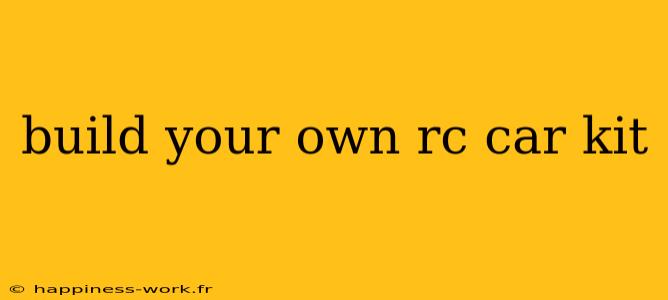Building your own RC (Radio Control) car can be an incredibly rewarding experience. It offers not only the thrill of construction but also the satisfaction of racing a vehicle you designed and built yourself. In this article, we will explore the essential steps to build your own RC car kit, providing insights and additional information to make the process as enjoyable and efficient as possible.
Why Build Your Own RC Car?
Before we dive into the details, you might be wondering why you should build your own RC car instead of purchasing a pre-assembled model. Here are a few compelling reasons:
- Customization: Building your own RC car allows you to tailor it to your preferences, from the design to the specifications.
- Learning Experience: The assembly process enhances your understanding of how RC cars work, giving you valuable mechanical and electronic knowledge.
- Cost-Effectiveness: While some kits can be pricey, building your own can save money in the long run, especially if you already have some components.
Steps to Build Your Own RC Car Kit
Here, we’ll outline the process of building your own RC car, including essential components, tools needed, and tips to enhance your build.
1. Gather Your Components
To begin, you need to assemble a few essential components. Here are the basics you will need:
- Chassis: This is the frame of your RC car, which holds all the parts together.
- Wheels and Tires: Choose a set that suits the type of terrain you will be driving on.
- Motor: An electric motor powers your car, and there are various types available depending on the speed you desire.
- Electronic Speed Controller (ESC): This device regulates the speed of the motor.
- Battery: Make sure you have a suitable battery that meets the voltage and capacity requirements of your motor and ESC.
- Remote Control System: This typically includes a transmitter (the controller) and a receiver (the part that communicates with the car).
- Servo: Used for steering your RC car.
Additional tips: Refer to the specifications in your RC car kit for compatibility to ensure all parts work together smoothly.
2. Assemble the Chassis
Once you have gathered your components, start by assembling the chassis. This is where you will attach all the components you just collected.
- Instructions: Follow the assembly manual included in your kit closely. If there isn’t one, many tutorials are available online, including detailed videos.
- Secure Fastenings: Make sure all screws and fasteners are tight but not over-tightened, which could damage the plastic parts.
3. Install the Motor and ESC
After the chassis is ready, install the motor and ESC:
- Motor: Attach the motor to the designated area on the chassis, ensuring it's securely fastened.
- ESC: Connect the ESC to the motor according to the wiring diagram provided in your kit.
Practical Example: If you are using a brushed motor, ensure that you connect the wires according to the color coding to avoid reversing polarity.
4. Connect the Battery and Receiver
Next, connect the battery and receiver:
- Receiver: Position the receiver in a spot where it can receive a clear signal from the remote control, usually towards the front of the chassis.
- Battery: Secure the battery in place, ensuring it’s easily accessible for charging and replacement.
5. Set Up the Wheels and Tires
Now, it's time to install the wheels and tires:
- Wheels: Attach the wheels to the axles. Depending on your design, this could involve simple snap-on wheels or screws.
- Tires: Ensure the tires are appropriately fitted and inflated (if they are inflatable).
Note: Choosing tires designed for specific terrains (e.g., off-road vs. on-road) will significantly affect your RC car's performance.
6. Test Your RC Car
Before you take your RC car for a spin, conduct a thorough check:
- Functionality Test: Turn on the system and make sure the motor runs and the steering operates smoothly.
- Range Test: Check the range of your remote control to ensure it works over the intended distance.
Tip: Always test in a safe, open space where you can control the car without hazards.
Additional Tips for Enhancements
- Upgrades: Consider upgrading components like the motor or battery for better performance as you become more experienced with building.
- Maintenance: Regular maintenance can prolong the life of your RC car. This includes cleaning the parts, checking connections, and replacing worn-out tires.
- Community Involvement: Engage with online forums or local RC clubs to share experiences, seek advice, and participate in races.
Conclusion
Building your own RC car kit is a gratifying project that combines creativity, engineering, and a love for cars. By following these steps and utilizing the provided tips, you can create a unique and enjoyable RC vehicle tailored to your preferences. Don't forget to embrace the learning process and have fun!
Remember: Information presented here was inspired by various resources, including Wikihow, which provided foundational insights on this topic. For those looking to dive deeper, a wealth of information is available online. Happy building!
By following these instructions and insights, you are well on your way to creating your own RC car. Enjoy the ride!
